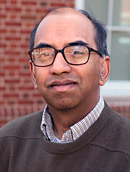 Core ICM Faculty Member and Associate Research Professor of Biomedical Engineering, Tilak Ratnanather, is among the authors of a letter published in Science that illustrates the need for a network for deaf and hard-of-hearing (D/HH) trainees and the success of a mentor-based networking model that has evolved over the past 25 years. The Letter, “Community network for deaf scientists,” shown below was originally published in the April 2017 edition of Science:
Core ICM Faculty Member and Associate Research Professor of Biomedical Engineering, Tilak Ratnanather, is among the authors of a letter published in Science that illustrates the need for a network for deaf and hard-of-hearing (D/HH) trainees and the success of a mentor-based networking model that has evolved over the past 25 years. The Letter, “Community network for deaf scientists,” shown below was originally published in the April 2017 edition of Science:
“We are a community of scientists who have personally experienced the barriers imposed by hearing loss described by G. Buckley et al. in their Letter “Building community for deaf scientists” (20 January, p. 255). They propose an institutional hub for deaf and hard-of-hearing (D/HH) trainees to build their scientific careers. We have created an alternative model of distributed academic peer networking that has grown and evolved over the past 25 years. This model has enabled us to overcome personal and professional barriers while promoting the inclusion of numerous D/HH scientists at all levels of biomedical research. The majority of the network is composed of hearing-impaired members of the Association for Research in Otolaryngology (HI-ARO). The HI-ARO community originated in 1992 with just three D/HH scientists and has grown globally to more than 60 members, including undergraduates, professors, audiologists, physicians, graduate students, medical residents, postdoctoral fellows, and leaders in health care and industry.
“Our experience indicates that the diversity of challenges hearing loss creates is manageable by the deployment of strategies that facilitate effective communication between hearing and D/HH scientists. Speech, cued speech, sign language, and other communication modalities are all valued. This distributed model of integration requires each D/HH member to make a career-long commitment to mentorship of others with hearing loss to propagate successful solutions to individual challenges that are surmountable with inspired and motivated input. Quality mentorship is vital for trainees and junior scientists to achieve career goals (1–3) and is perhaps more critical for D/HH scientists who intrinsically face communication challenges (4).
“The unique experiences, skills, and expertise of each D/HH scientist in our community empower the model and have advanced scientific understanding across the wider biomedical community. Most of us meet in person at the annual meeting of the ARO (as well as other professional conferences), where our network has secured equal access to podium and poster sessions through sign language interpreters, hearing-assistive technology, and real-time captioning. The efficacy of our distributed model of peer support, mentorship, and integration with the wider scientific community is validated in part by those members of HI-ARO who have become academic faculty (4–6), secured competitively funded national research awards, and published influential manuscripts in high-impact journals [e.g., (7–10)].
“Given the demonstrated success of this distributed model of mentorship, we believe that federal and philanthropic efforts to increase diversity should not be limited to a proposed hub model in a single geographic area that focuses primarily on trainees. An alternative approach is to scale up our distributed model of mentoring D/HH pre- and postdoctoral trainees, with a particular focus on junior faculty competing for research awards who will serve as the next generation of mentors. The distributed model will continue to raise awareness of the societal cost of hearing loss and energize the trajectories of D/HH scientists globally. The distributed and hub models are not mutually exclusive and an open dialogue to investigate their synergistic alignment may be highly beneficial.”
In addition to co-authoring the letter, Dr. Ratnanather has submitted a proposal to the Johns Hopkins Idea Lab to support the captioning of seminars for summer research students with hearing loss. With enough votes, the project could receive funding and could be an important step towards facilitating increased representation of persons with hearing loss in science and medicine which currently stands at about 1%.

